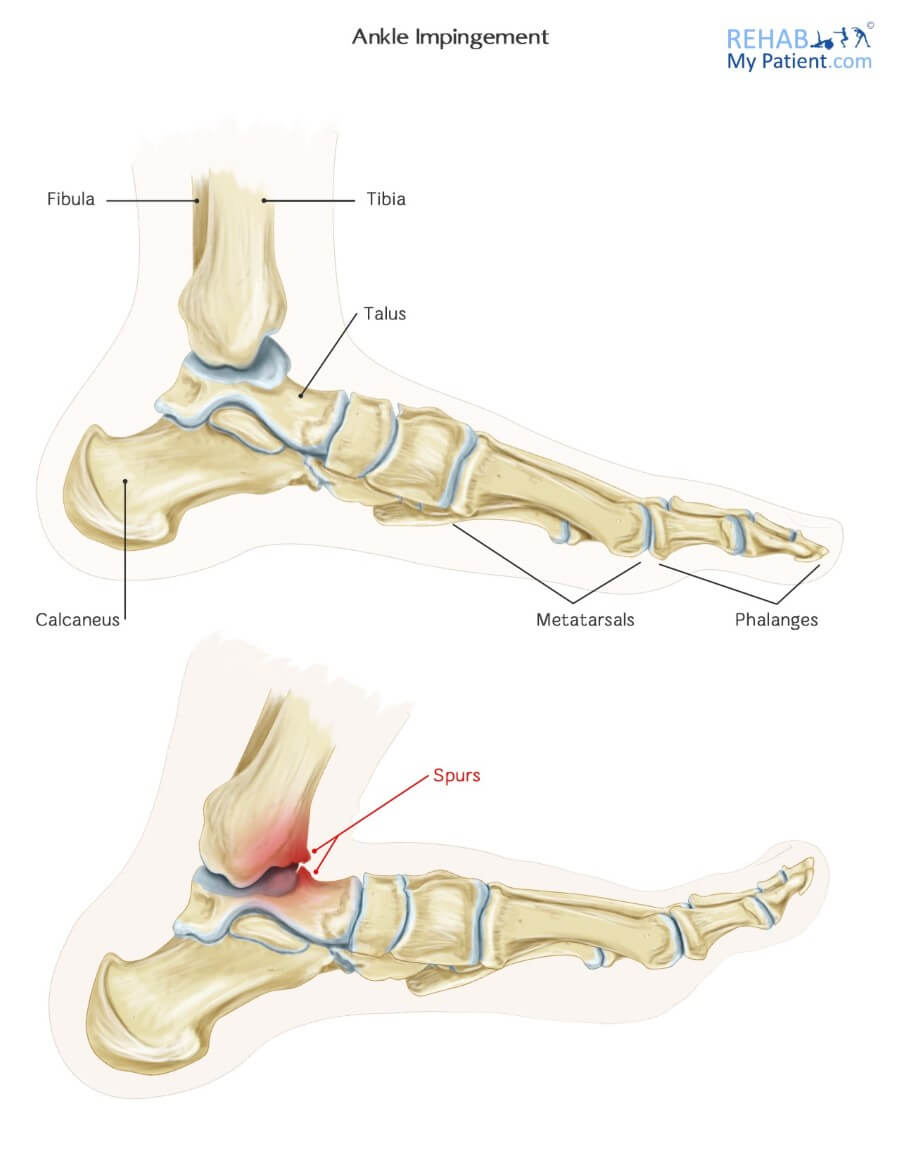Ankle Impingement (Anterior)
Posted on 12th Mar 2017 / Published in: Ankle

Ankle impingement, once termed athlete’s ankle or footballer’s ankle, is one of the sources of chronic pain that athletes see on a regular basis. It often occurs when a bone spur develops on the front part of the ankle. When this happens, the athlete might end up developing bone spurs that impinge on each other at the ankle joint. While not always an athlete’s problem, it is generally considered an overuse/repetitive trauma injury.
The condition often occurs in an athlete who has played sports for years involving a kicking motion, which causes repeated extremes of motion either down or up. Sports involve a forceful motion of the ankle joints that place an enormous amount of pressure on the joints themselves. This overuse injury tends to progress slowly over the course of time. Athletes are often over the age of 25 and have participated in the sport for an extended period of time. Some athletes will develop pain, while others will be able to compete without any difficulty.
Ankle Impingement Anatomy
Ankle joints have two bones that pivot and glide over each other, the talus and the tibia. There is a thick covering surrounding the entire ankle joint that keeps all of the joint fluid within the ankle joint. Synovial fluid and the smooth cartilage lining the end of the bone in the joint let the ankle joint move with a minimal amount of friction.
Ankle impingement is a condition in which bone spurs form in the front of the ankle joint and can form in either the end of the shin bone (the tibia) or on top of the ankle bone itself (the talus). In some instances, the bone spurs can form in both the tibia as well as the talus. While various factors can cause ankle impingement, it is most widely caused by repetitive micro-trauma or overuse. As seen in the picture below, ankle impingement can prove to be a painful condition.

How to treat an ankle impingement:
1. No quick fix – surgery may be an option
There's no quick fix to ankle impingement but that doesn't mean you cannot do something about it. In most instances, you'll need to see a physician or specialist for expert guidance on the management. Surgery is certainly an option to remove the bone spurs.
2. Avoid Activities
The first line of treatment for an ankle impingement is to avoid any activities that bring on symptoms. You may have to refrain from athletic participation. During the rest period, athletes should remain active in conditioning methods that don’t continue to create forceful movements in the ankle or bring on symptoms.
3. Anti-Inflammatory
Regular use of an anti-inflammatory with an ice pack will help to minimize any swelling that you currently have. Use ice for 5 to 10 minutes at a time three to five times per day. This combination will help to decrease pain by eliminating the swelling in the ankle.
4. Injections
Even though repeated use of these injections isn’t recommended, they can help to relieve the pain associated with the condition on a short-term basis. Don’t have more than 3 injections though as it can cause some tendon weakness.
5. Physical Therapy
Working with a physical therapist proves beneficial to a number of individuals. These professionals work alongside professionals to alter motion for the lower extremities by developing a plan based on the specific sport that the athlete participates in. Therapists may also check your gait.
Tips:
1. Investing in a quality pair of shoes will go a long way in ensuring that you don't suffer from ankle impingement or bone spurs of any kind. In order to do that, you'll need to know what type of shoes that you need. Visit your local shoe store and ask them to recommend a good quality sports shoe.
2. Patients showing evidence of arthritis in the ankle at the time they undergo surgery will find improvement in their condition, but it isn’t as beneficial as those who don’t have arthritis present.
3. If you think you have an ankle impingement, you need to seek urgent attention from a trained professional.
4. To regain full competition participation, expect to spend anywhere from three to six months recovering after surgery.
5. Between 80 and 90 percent of individuals undergoing surgery return to participate in sports at the same level or better as before the injury occurred.
6. Refrain from participating in activities that cause the injury to worsen as it might be doing more damage than good.
7. If you do have surgery, make sure you see a physical therapist, physio, or sports massage therapist to improve range of mobility to your ankle as quickly as possible.
Sign UP
Sign up for your free trial now!
Get started with Rehab My Patient today and revolutionize your exercise prescription process for effective rehabilitation.
Start Your 14-Day Free Trial